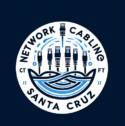What Are the Three Types of Cabling? A Complete Guide to Network Connections
If you’ve ever wondered what the three types of cabling are and how they affect your network performance, this guide is for you. Cables are the lifelines of any communication or data network — from the internet in your home to the complex infrastructure that powers entire businesses. Understanding the main types of cabling helps you choose the right one for your setup, ensuring speed, stability, and long-term reliability. Our team of professional network cabling installers in Santa Cruz ensures every system is designed with the right type of cable for maximum performance and reliability.
The Three Main Types of Cabling
In structured cabling and networking, there are three primary types of cables used to transmit data and communication signals:
- Twisted Pair Cable (Ethernet)
- Coaxial Cable
- Fiber Optic Cable
Each type has its own advantages, limitations, and ideal use cases. Let’s break them down.
1. Twisted Pair Cable (Ethernet)
Twisted pair cable is the most common type of cabling used in homes and businesses for network connections. It consists of pairs of insulated copper wires twisted together to reduce electromagnetic interference (EMI).
There are two main types of twisted pair cables:
- Unshielded Twisted Pair (UTP): Used in most Ethernet networks (like CAT5e, CAT6, and CAT6a). It’s flexible, affordable, and easy to install.
- Shielded Twisted Pair (STP): Includes a protective shield around the wires to reduce interference, often used in industrial or high-noise environments.
Best for:
- LAN networks
- Home internet
- Office workstations
- CCTV and VoIP systems
Typical Speed: Up to 10 Gbps (with CAT6 or CAT6a)
Pros:
- Affordable and widely available
- Simple installation
- Good for short to medium distances
Cons:
- Signal quality can degrade over long distances
- Susceptible to interference if not shielded properly
2. Coaxial Cable
Coaxial cable, often referred to as “coax,” has been around for decades and is still used in many television, internet, and CCTV applications. It features a central copper conductor surrounded by insulation, a metallic shield, and an outer cover.
How it works:
The shielding protects the signal from interference, allowing for reliable transmission over long distances.
Best for:
- Cable television (CATV)
- Broadband internet
- CCTV surveillance systems
Typical Speed: Up to 1 Gbps depending on quality and use
Pros:
- Excellent shielding from interference
- Durable and long-lasting
- Works well for long-distance runs
Cons:
- Bulkier and less flexible
- Lower data capacity compared to modern Ethernet and fiber
3. Fiber Optic Cable
Fiber optic cabling is the fastest and most advanced of the three. Instead of copper, it uses strands of glass or plastic fibers to transmit data using light pulses. This makes it capable of extremely high speeds and long-distance data transmission without signal loss.
Two main types of fiber optic cables:
- Single-mode fiber (SMF): Ideal for long-distance communication (up to 40 km or more).
- Multi-mode fiber (MMF): Used for shorter distances, typically within buildings or campuses.
Best for:
- Data centers
- Internet service providers (ISPs)
- Large enterprises
- High-speed backbone cabling
Typical Speed: 10 Gbps to 100+ Gbps
Pros:
- Ultra-fast data transfer
- Immune to electromagnetic interference
- Can handle long distances without degradation
Cons:
- More expensive than copper cabling
- Requires professional installation and specialized tools
Choosing the Right Type of Cabling
The right cable depends on your network needs, budget, and environment.
| Application | Recommended Cable | Reason |
|---|---|---|
| Home network | CAT6 (Twisted Pair) | Fast, affordable, easy to install |
| Office building | Structured cabling with CAT6a or fiber backbone | Scalability and performance |
| CCTV system | Coaxial or CAT6 (depending on camera type) | Reliable signal for security systems |
| Data center | Fiber optic | Maximum speed and distance |
| Industrial setting | Shielded twisted pair (STP) | Protection from interference |
If you’re unsure which type is best for your setup, a professional cabling technician can assess your needs and recommend the most efficient solution.
Common Mistakes to Avoid
Even with the right type of cabling, poor installation can cause major performance issues. Avoid:
- Mixing old and new cable types
- Ignoring cable length limits
- Failing to label and document cables
- Running data and power cables too close together
Professional installers follow structured cabling standards like ANSI/TIA-568 to ensure your network runs efficiently and safely.
Final Thoughts
Understanding the three types of cabling — twisted pair, coaxial, and fiber optic — helps you make informed decisions when setting up or upgrading your network. Each has its strengths, and often, a combination of all three is used in modern infrastructure to achieve the best performance. Aside from these three, there are more classifications worth noting — explore the four types of network cables to understand their unique roles in different setups.
Whether you’re designing a small office network or a large commercial facility, professional installation ensures your cabling system is efficient, compliant, and future-ready.
For expert advice and installation, contact your local structured cabling professionals in California to get started with a customized solution that fits your needs.
